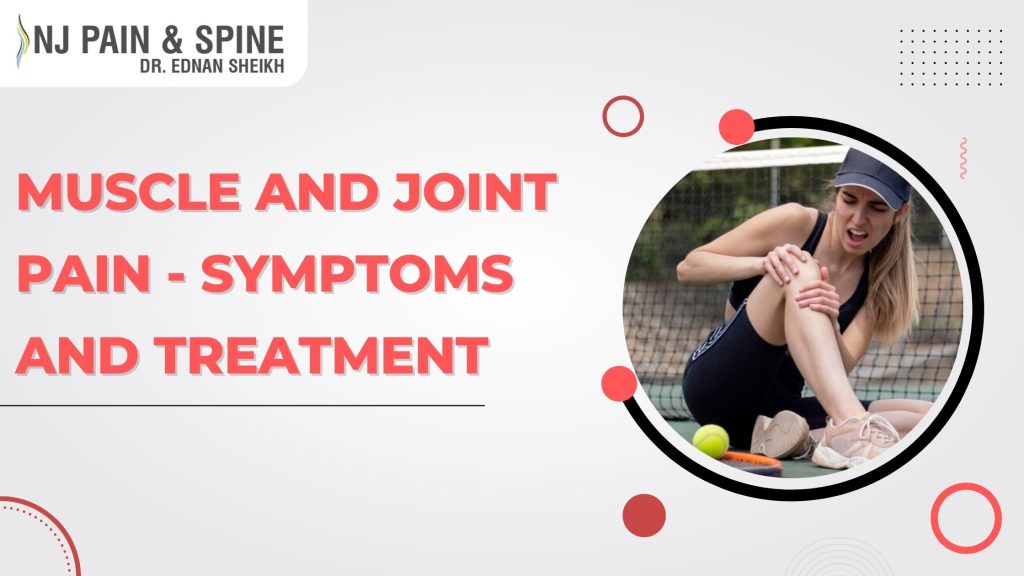
There are many reasons why Muscle and Joint Pain, including injuries, intense exercise, poor posture, and medical conditions (such as myositis, infections, and arthritis).
Body parts affected by this condition usually exhibit pain, stiffness, and limited range of motion.
An experienced pain management physician usually makes the diagnosis based on the patient’s history and physical examination. It might also be necessary to perform other lab tests and imaging studies, such as an x-ray scan.
In addition to resting, physiotherapy, painkillers, warm packs, and gentle massages, muscle and joint pain can be treated with painkillers, ice packs, and heat packs.
It is important to keep good posture when working, to warm-up and cool-down before and after sports, and to avoid accidents to prevent acute muscle and joint pain. It is also possible to prevent some muscular and joint pain caused by infections by maintaining good hygiene practices.
Within a few days, the pain usually subsides. Some cases, however, may take longer to recover, and the pain can sometimes become chronic depending on the cause.
Acute pain in muscles and joints can be caused by a variety of factors:
In most people’s lives, they will experience acute muscle or joint pain at some point. Pain in the muscles and joints is most caused by:
- Poor posture
- Injuries to muscle, tendon, cartilage, bone, etc
- Dislocation of joints
- Muscle strains
- Intensive sports
- Fractures
Symptoms of muscle and joint pain
Pain and discomfort are the most common symptoms in the affected areas, causing some inconvenience during daily activities. In some cases, the pain only occurs when the joint is used, while in others it occurs sharply stabbing every few minutes. Here are some of the most common symptoms:
- Muscle twitch
- Fatigue
- Pain
- Stiffness
- Sleep disturbance
- Reduced mobility
Having a diagnosis
A pain management physician or other healthcare professional can diagnose muscle and joint pain based on your medical history, symptoms, and physical examination.
To confirm the cause, additional blood tests and imaging studies, such as an X-ray, CT scan, or MRI, may be necessary.
Muscle and joint pain treatment
After resting the affected part, most cases of acute muscle and joint pain, including the lower back, upper back, wrists, elbows, ankles, knees, and fingers, resolve within days. You can, however, help yourself by following these suggestions:
- Packing that is warm and cool.
- Prescription pain relievers.
- Exercises that strengthen and stretch the muscles, such as physiotherapy.
- Using stress reduction techniques.
- Treatment with acupuncture
- An antibiotic, anti-inflammatory drug, or surgical treatment may be prescribed for specific causes.
Muscle and joint pain prevention
Several strategies can be used to prevent acute muscle and joint pain. To avoid wrist and back pain, you should keep good posture while typing, warm up and cool down your muscles and joints before and after sporting activities and avoid accidents. Infection-related muscular and joint pain can also be prevented through good hygiene practices.
Frequently Ask Questions
Why do joints and muscles hurt?
A disease of inflammation of the joints, rheumatoid arthritis. Inflammatory cells collect in the body, causing septic arthritis.
Why do You have muscle and joint pain all over my body?
It’s common to have muscle pain that affects a small part of your body due to overuse — for example, sore arms after lifting boxes all day. Perhaps it’s just a bruised shoulder after a fall, or even a minor injury. Infections, illnesses, or medicines are more likely to cause body aches.
What causes muscle and joint pain throughout the body?
It is sometimes called body aches. Various causes of muscle and joint pain can occur, including injuries, intense work or sports, poor posture, and medical conditions (such as infections and myositis). Body parts affected by this disease experience pain, stiffness, and a limited range of motion.
Final Words
It usually takes a couple of days for acute muscle and joint pain to subside. It may take longer to recover, and the pain might become chronic in some cases, depending on the cause. Insidious back pain or carpal tunnel syndrome can result from long-term poor posture when working on a computer, for example. If you are suffering from Muscle or Joint Pain, you can seek treatment at NJ Pain & Spine Institute.
For an appointment simply contact now!




